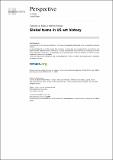Global turns in US art history
Author(s)
Nelson, Steven; Jones, Caroline A
DownloadGlobal turns in US art history.pdf (514.0Kb)
OPEN_ACCESS_POLICY
Open Access Policy
Creative Commons Attribution-Noncommercial-Share Alike
Terms of use
Metadata
Show full item recordAbstract
Although globalization feels recent, questions directed at nationalism from a more worldly perspective were already being posed during the Great War. In 1916, for example, US legal scholar Randolph Bourne wrote an essay entitled “Trans-National America,” in which he advocated for a cosmopolitan mixture of cultures rather than the “melting pot” that had long been promoted in the United States (BOURNE, 1916). Across the Atlantic (and within the enemy country), philosopher Franz Rosenzweig was rhapsodizing in Frankfurt about “world-historical spatial concepts” in his 1917 essay “Globus” (ROSENZWEIG, 1984). These prophetic intellectuals had no impact whatsoever on American art history, which remained, paradoxically, both provincial and fixated on Europe for at least the first half of the twentieth century, largely ignorant of universalist and transnational debates. The “global turn” happened in US art history most dramatically after the fall of Communism, when the giddy fantasy of a one-world economy galvanized thinking in the academy, spanning from the humanities to social science and political theory. This essay traces the stuttering history, and future potential, of global thinking in art history as the discipline evolved in the United States. We will begin with a brief summary of the development of the field in this country, and then review the contextual forces and historical scholarship that established the landmarks of a new art history aspiring to globality. In conclusion, we will offer a polemic: that it is with the histories of art and architecture in the Cold War that “the global” becomes a necessary analytical tool.
Date issued
2015-12Department
Massachusetts Institute of Technology. Department of ArchitectureJournal
Perspective
Publisher
Institut national d’histoire de l’art (INHA)
Citation
Jones, Caroline A., and Steven Nelson. “Global Turns in US Art History.” Perspective 2 (2015).
Version: Author's final manuscript
ISSN
1777-7852
2269-7721